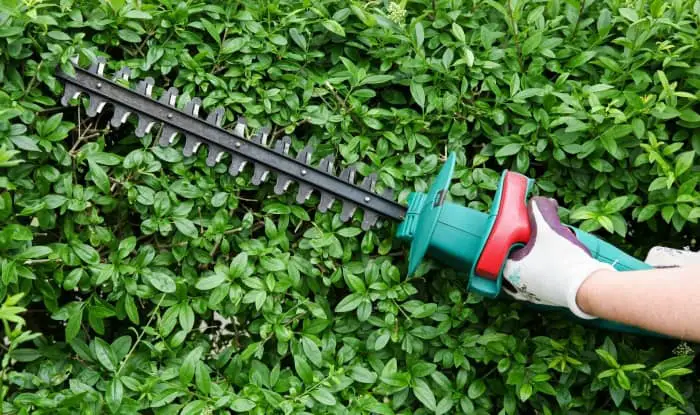It’s convenient to have tools that can be used for more than one purpose when working in your yard.
Hedge trimmers are powerful tools that can cut through the hard stems of woody plants. So when used correctly, a hedge trimmer can also cut most weeds down to size.
So in this article, we look at the important things to consider when cutting weeds with a hedge trimmer.
Let’s dive in.
Can You Cut Weeds With A Hedge Trimmer?
You can cut weeds with a hedge trimmer. Hedge trimmers have a powerful cutting action that can easily cut through the stems of most weeds that are usually softer than the woody stems you find on hedges.
But while it’s easy to cut weeds with a hedge trimmer, it’s important to remember that some weeds can grow back if you only cut them without killing or removing the roots. Perennial weeds with well-established root systems often regrow from pieces of roots and rhizomes left in the ground. So you might have to cut the weeds repeatedly to exhaust their root systems.
Because it’s difficult to kill some types of weeds by cutting, it’s worth considering whether there are more effective methods available. Systemic weed killer is a common way of killing the roots of weeds to prevent them from regrowing. And manual removal of weeds with their roots also prevents plants from regrowing.
If weeds are growing in the hedge that you’re trimming, it’s worth cutting them at the same time. You can then consider whether you want to employ any additional methods to completely remove the weeds. Sometimes cutting the weeds down is enough to kill them.
Related: Should I Cut Weeds Before I Spray Them?
Type Of Weeds
Before deciding to use a hedge trimmer, you should consider the weeds you are trying to cut.
You can use a hedge trimmer to cut any type of weeds. But if the weeds are small annual weeds with shallow root systems that are easily pulled from the ground or cut with a gardening knife, then a hedge trimmer might be overkill. If you want to clear thick brush, brambles, or weeds with thick stems, then a hedge trimmer will make the job much easier compared to other cutting tools such as a trimmer.
Type Of Blade
You can get a range of blade sizes for your hedge trimmer that help you to reach further as you cut and shape your hedges. When choosing a hedge trimmer that you also want to use for cutting weeds, consider the size and strength of the blade, especially if you have thick brush to clear or weeds with woody stems.
Tool Selection
A gas-powered hedge trimmer is usually the best choice for cutting thick and overgrown areas of weeds. Gas-powered hedge trimmers are more powerful than electric models. And because they’re cordless, it’s easier to move a gas-powered trimmer around your garden, enabling you to cut weeds over a larger area.
Choose a hedge trimmer that’s light enough for you easily handle. Cutting weeds can require dexterity. You might also find it easier to cut weeds with a double-sided blade rather than a hedge trimmer with a single blade.
Safety
Hedge trimmers are powerful tools with sharp blades. So it’s important to take safety precautions when using a hedge trimmer to cut weeds. You should wear gloves for your hands and protective safety goggles or a visor to protect your eyes.
Sometimes the blade can become clogged as you cut through thick weeds and vines, so switch the hedge trimmer off and use a brush to clear the debris before continuing.
You should also be careful not to cut weeds while they are wet. Wait for dry conditions before you start work.
Alternatives You Can Use
You can control some lawn weeds using your lawn mower at the same time as you cut the grass. Another helpful tool for cutting weeds and grass is a string trimmer. Grass shears, pruning shears, and weeding knives are useful if you just have the occasional weed to cut. And for thick brush and bamboo, you can also consider using a brush cutter or pole saw.

